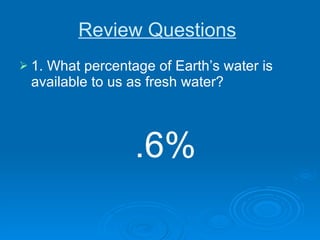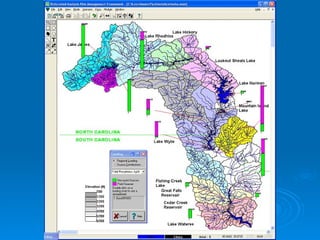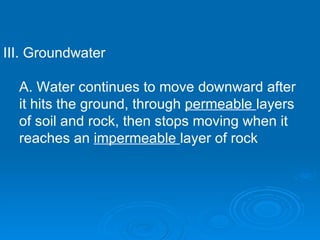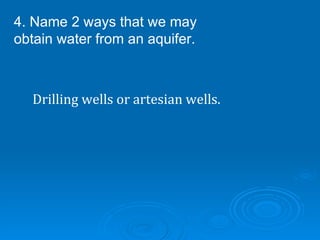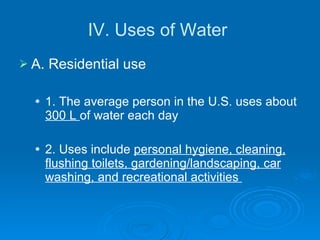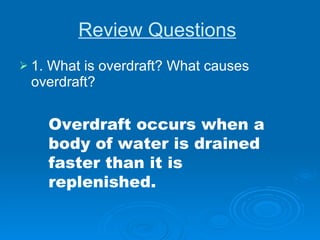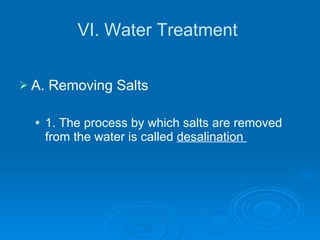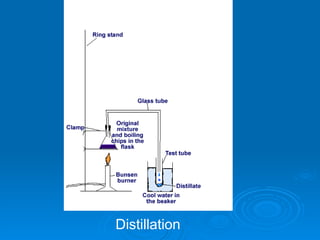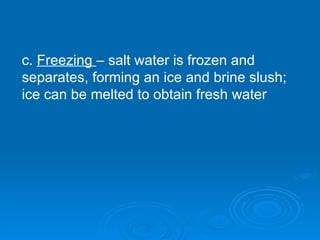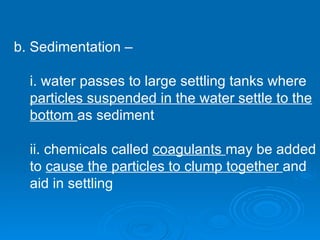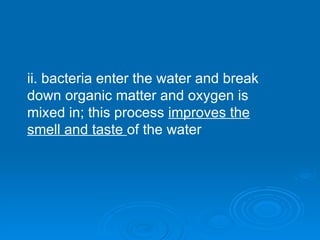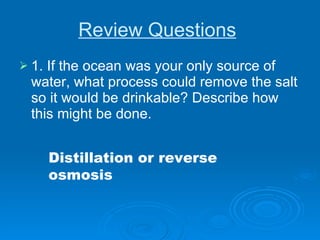Chapter 14 – water resources
- 1. Chapter 14 – Water Resources Where does your drinking water come from?
- 2. I. Earth’s Water Supply A. Where is Earth’s water? 1. 97.2% - oceans 2. 2.2% - icecaps and glaciers 3. 0.6% - surface or groundwater
- 3. B. Earth’s supply of fresh water is continuously being renewed through the water cycle 1. Definition – the movement of water from the oceans and freshwater sources to the air and land and finally back to the oceans
- 5. 2. Processes: a. evaporation – from surface water, soil and organisms b. condensation – air containing water vapor cools and forms clouds c. precipitation – rain, sleet, snow, or hail i. may run-off into surface water ii. may infiltrate into groundwater
- 6. Review Questions 1. What percentage of Earth’s water is available to us as fresh water? .6%
- 7. 2. Draw a simple diagram of the water cycle and label the 3 main processes.
- 8. II. Surface Water A. Running Water 1. Includes rivers and streams 2. May enter through surface run-off from the surrounding watershed (the land area from which surface run-off drains into a system of rivers and streams)
- 10. B. Standing Water 1. Includes lakes, ponds, wetlands (ie. swamps and marshes), and reservoirs 2. Form when run-off gets caught in low places , or by artificial means
- 11. III. Groundwater A. Water continues to move downward after it hits the ground, through permeable layers of soil and rock, then stops moving when it reaches an impermeable layer of rock
- 14. B. Water table – the level below which the ground is saturated with water 1. May be high in some areas (ie. near the sea, or in low-lying forests), and deep in others (ie. deserts) 2. Depth may change with precipitation, drought, or overuse of wells
- 16. C. Aquifers – layers of rock or sediment that allow groundwater to pass freely; sources of groundwater 1. Rate of movement varies with amount of precipitation, porosity of the rock, and slope of the aquifer
- 18. 2. Groundwater may leave the aquifer and become surface water at the “ zone of discharge ”, may pump out on its own (when under pressure) through an “ artesian well ”, or may be accessed by drilling wells
- 19. Artesian Well
- 21. Review Questions 1. What is a watershed? How does water get from a watershed to a river? The land area from which water drains into rivers and streams.
- 22. 2. Describe how groundwater forms. Water moves down through the ground through permeable layers of rock until it hits an impermeable layer.
- 23. 3. What causes the differences in the depth of the water table? Precipitation Drought Overuse
- 24. 4. Name 2 ways that we may obtain water from an aquifer. Drilling wells or artesian wells.
- 25. IV. Uses of Water A. Residential use 1. The average person in the U.S. uses about 300 L of water each day 2. Uses include personal hygiene, cleaning, flushing toilets, gardening/landscaping, car washing, and recreational activities
- 26. B. Industrial use 1. About 44% of all fresh water is used by industry 2. Uses include transporting goods, disposal of waste, generating power, cooling machinery, mining and refining natural resources, manufacturing raw materials , and producing synthetic materials
- 27. C. Agricultural use 1. The single largest user of water in the U.S. (almost ½ of all freshwater use) 2. Irrigation – the process of bringing water to an area for use in growing crops
- 29. Review Questions 1. Compare your daily residential use of water to that of a person in a developing country (like Kenya). What ways do you use water that they probably do not? -daily shower -wash cars
- 30. 2. Make a list of all of the ways that you have used water so far today. Don’t forget to include industrial and agricultural uses!
- 31. V. Water Resource Problems A. Overdraft 1. Occurs when a body of water is drained faster than it is filled ; may occur in surface water or groundwater Ex. The Ogallala aquifer is the largest aquifer in the world and supplies water to 8 midwestern states; the water in this aquifer is expected to last only 40 more years
- 33. 2. Other problems with overdraft– a. intrusion of salt water into freshwater aquifers b. subsidence , or sinking, of bedrock
- 35. B. Habitat degradation or destruction 1. Includes water diversion (changing stream courses), building dams and reservoirs , and draining wetlands
- 36. Extinct woodpecker because of habitat loss
- 37. 2. Damages or destroys habitat of aquatic organisms such as fish, amphibians, and invertebrates, as well as migratory birds
- 39. Review Questions 1. What is overdraft? What causes overdraft? Overdraft occurs when a body of water is drained faster than it is replenished.
- 40. 2. Why do humans change stream courses, build dams and reservoirs, and drain wetlands? The main reason is to develop the land.
- 41. 3. What do humans need to do in order to solve some of our water resource problems? Make water conservation a priority.
- 42. VI. Water Treatment A. Removing Salts 1. The process by which salts are removed from the water is called desalination
- 43. 2. Methods: a. Distillation – water is heated to boiling so water evaporated but salt remains; water vapor is cooled and fresh water collected b. Reverse Osmosis - salt water is forced through a strainer that traps the salt and lets the fresh water pass
- 44. Distillation
- 45. c. Freezing – salt water is frozen and separates, forming an ice and brine slush; ice can be melted to obtain fresh water
- 46. B. Water Purification Water Purification 1. This process removes harmful chemicals and microorganisms that make the water unpotable , or unfit to drink 2. Process: a. Screening – traps and removes large debris from water
- 47. b. Sedimentation – i. water passes to large settling tanks where particles suspended in the water settle to the bottom as sediment ii. chemicals called coagulants may be added to cause the particles to clump together and aid in settling
- 48. c. Filtration – water is passed through a filtering material such as fine sand to remove smaller particles
- 49. d. Aeration – i. water is exposed to air and sunlight by allowing it to spray into the air or flow as a waterfall
- 50. ii. bacteria enter the water and break down organic matter and oxygen is mixed in; this process improves the smell and taste of the water
- 51. e. Sterilization – water is exposed to extreme heat or chemicals such as chlorine in order to remove harmful bacteria and microorganisms
- 53. Review Questions 1. If the ocean was your only source of water, what process could remove the salt so it would be drinkable? Describe how this might be done. Distillation or reverse osmosis
- 54. 2. What does “unpotable” mean? It means that it is unsafe to drink.
- 55. 3. Name the 5 steps of the water treatment process. Screening Sedimentation Filtration Aeration Sterilization





